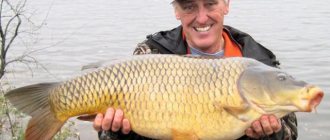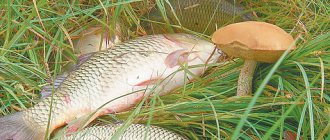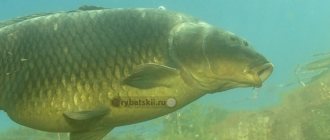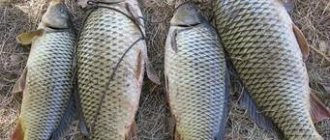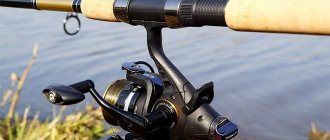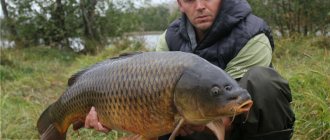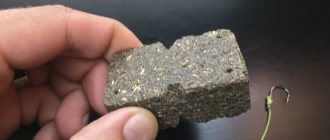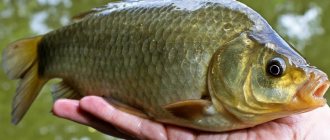Ideal bait for carp
Every fisherman knows about the love of carp for corn. Carp, being a fellow carp, is no exception - in the summer season, bright grains are especially attractive to it . Carp like both the color and aroma of corn, so it is good to use it not only as bait, but also as complementary food.
Corn is also convenient for the fishermen themselves.
Firstly, it is available - if not fresh, then canned. Secondly, it is easy to place grains on a hook or hair, and even a novice fisherman can cope with this task. Thirdly, corn is universal in terms of compatibility with gear - it can be used with a classic fishing rod, donka and feeder. Finally, each fisherman can choose the type of corn that is most convenient for him: canned from a can , with flavor from a fishing store, or cooked with his own hands.
Corn kernel bait: preparation
When preparing to fish for carp, you can take the simple and easy route by buying a can of canned corn at the store. This is a perfectly acceptable bait, but there can be pitfalls here too. First of all, canned food must be of high quality, so you should not skimp. Among carp hunters, Bonduelle corn is considered the most suitable for fishing.
But even a high-quality product needs to be sorted. Pressed or damaged grains must be removed from the jar; they are not suitable for bait. The grains must be whole and dense so that they can be placed on the hook without any problems.
But the easy way is not always the most successful, so there are more complex methods of preparing the “queen of the fields” for fishing.
So, in addition to canned corn, corn is used:
- Fermented.
- Steamed.
- Corn porridge (mamalyga).
- Fresh.
Only fresh grains do not require special preparation. All other baits have special preparation recipes, which will require some time. The fastest way will take a little more than a day.
The fermented grain takes about a week to prepare.
The process is not complicated and takes place in several stages:
- Soak the grains (from one to two days).
- Rinse.
- Boil for 40-60 minutes (the grains should not be boiled);
- Transfer the cooked grain into a large bottle, add flavoring and fill with cold water;
- Add a little yeast, stir, leave to ferment;
- The process is completed in three to four days.
There are a few things to consider when fermenting.
Firstly, it is important not to overcook the grains, as they may become sour. Although some experts claim that this kind of bait can attract large fish.
Secondly, after the yeast is added to the grains, you need to add a couple of teaspoons of vegetable oil to prevent air from entering the bottle. In this case, there is no need to close the neck.
Thirdly, fermented grains can be stored in the refrigerator in a sealed container for no more than a month.
The recipe for steamed corn is simpler, and it cooks faster using boiling water and a thermos:
- soak the grains for 24 hours (change the water several times);
- fill a thermos with a glass flask one-fourth of the volume with corn;
- add flavoring and pour boiling water, close tightly;
- We wait four hours - and the bait is ready.
Cooking hominy is a little more difficult than steaming corn kernels, but it is a very catchable bait.
Hominy is prepared from two types of flour: corn and wheat:
- take three parts corn flour and one part wheat flour;
- Gradually adding water, knead the dough as thick as sour cream;
- add flavoring;
- put the dough in a thick plastic bag and tie it well;
- put the package in a pan with water, cook for at least half an hour (the longer, the harder the future attachment will be);
- Let the mamalyga cool along with the water.
We take the finished hominy in a bag fishing and cut it into pieces already there. Using hominy as bait will provide an additional incentive for biting.
Carp is also caught on fresh corn, which has just begun to ripen. But finding such grains is not easy.
The use of fresh corn is complicated by the fact that only grains of milky ripeness, that is, those that have not yet hardened, are suitable for bait. You can’t buy this kind of corn in a store; it can only be collected directly from the plant, during the short period when the grains begin to ripen.
The variety of corn baits is great and allows the angler to vary them, depending on the preferences of the carp.
But making corn bait is half the battle. It is important to skillfully place it on the hook.
Varieties
In fishing stores you can find special corn for fishing. It is also sold in cans, but is intended exclusively for fishing. The grains are selected by size, have sufficient density and are distinguished by enhanced aroma and color. In practice, there are no disadvantages, with the exception of one nuance - such corn costs more than branded canned corn.
It is also worth considering that the grain size is designed for large prey, so small carp will not be able to swallow the bait. By the way, some fishermen order artificial corn . It costs more than the canned one, but it sits tightly on the hook/hair, which allows you to use it many times. The disadvantage is that in some cases the smell is too strong, which may not please both the fisherman and picky fish.
DIY cooking
During the corn ripening season, fresh grains can also be used as bait. We are talking about very young, milky cobs. Such grains attract carp due to their naturalness. However, it will be mostly “trifles” that bite, and the bait itself may fly off at the moment of casting the fishing rod.
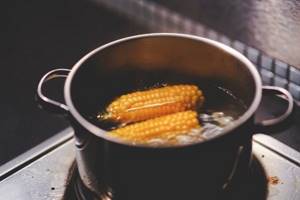
DIY corn
It is better to use already ripened cobs with fully formed grains. The grains themselves can be steamed for several days or boiled in boiling water - this will take no more than an hour. In both cases, flavorings are usually added to attract the attention of the carp.
Drunk
A special story is fermented corn, often called “drunk corn.” Its main advantage is a strong and persistent smell that attracts carp and its comrades. It will take several days or even weeks to prepare such a bait, which can also be used as complementary food.
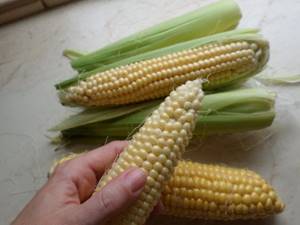
The process is as follows:
- Corn grains are boiled for an hour;
- Already boiled grains are placed in a jar, filling only a third of it, and filled with water at room temperature;
- Yeast and sugar are added at the rate of 10 g and 3 tbsp. spoons per 1 kg of grains, respectively;
- The jar is closed with a lid and placed in a dark place.
Corn gets drunk within 5 days. If you do not add yeast, the process will take a week or two . Finished grains do not have to be used immediately - they can be stored at a temperature of 0...+3.
Corn for bait
Corn is an excellent component of bait compositions, especially when fishing is carried out with this bait. When adding sweet grains to bait, it is recommended to first mash them, and use the liquid in which they were boiled or steamed to moisten the mixture.
Corn is added to ready-made factory baits or mixed independently with ground breadcrumbs, dry crushed cereals, ground cake or bran.
Knowing how to prepare corn and how to use it on a pond, you can be sure of a positive outcome when fishing for carp and carp.
Equipment
Catching carp with corn involves a fairly large catch. Therefore, in addition to the nozzle itself, you also need to prepare the equipment.
- Rod . You should choose a rod with a length of at least 3.9 m and no more than 5 m. Ideally, special carp models that are made of reinforced carbon and can withstand up to 10 kg of weight. For amateur fishing, standard feeder-type rods are sufficient.
- The reel seat and guide rings must be reliable. The reel should be used of the spinning type, with a spool size of 4000-5000. The presence of a baitrunner is welcome in still water.
- Fishing line . The ideal option is a thick monofilament line with a thickness of 0.3 mm and an elongation of 5-15%. An important point is color. You need to choose the most transparent fishing line, or one close to the color of the water, so as not to scare away the vigilant carp.
- Hooks . For catching carp, hooks No. 6-8 are usually used, but the choice depends on the expected size of the fish. The hook must be sharp so that the fish does not pull off the bait without biting. The length of the forend matters - it should be enough to plant several grains of corn.
Methods for mounting corn on a hook
With a very large number of rigs for catching carp, there are only two fundamental ways to mount (attachment) corn.
The classic method is to attach corn kernels directly to the hook. From three to ten grains are placed, and randomly - this is how the attachment looks natural. The grain is usually pierced at the “eye” - the attachment point in the cob. Most fishermen believe that the hook point should not be hidden. As a last resort, it is closed with a “corn sandwich” - a worm, maggot, bloodworm.
Hair accessories, which came to us from the British Isles, have become very popular in recent years. The main idea of its use is to place the bait (corn grains) outside the hook tip on the so-called “hair”, which is 1-3 cm behind the hook. Making equipment requires special training and tools (mounting needle, cambrics, stoppers, etc.) which is easy to access on the Internet. There are very simple options for making hair accessories - such as securing the hair with a loop in the middle of the hook's handle. However, it will be better if your mentor is a person who can show you how the equipment is made practically.
In addition to corn, carp bite well on Richworth and Mainline boilies.
Installation of gear
To catch carp, simple bottom equipment is usually used, including a tie with a sinker, a leash and a hook. The weight chosen is classic lead, weighing 25-125 g. The length of the leash, as a rule, does not exceed 15 cm.
An alternative option is a feeder.
In this case, the classic donka is complemented by a feeder with complementary foods. However, experienced fishermen are increasingly resorting to hair rigs in order not to miss the vigilant carp, which spit out a hook caught while “combing” the bottom. In addition, this method will allow you to secure the bait more securely and make longer casts. The essence of the hair rig is that the corn is not placed on the hook itself, but on a leash extending from it. This is how the carp swallows grains without noticing the hook, and eventually “sits” on it. You can make such equipment yourself, or buy a ready-made version in the store.
To summarize, we summarize: fishing with corn is a very obvious choice for fishermen who want to catch carp. This attachment is easy to use, versatile and affordable. And most importantly, carp love corn. Everything else is a matter of skill and luck!
Features of the technique of catching carp or carp using corn
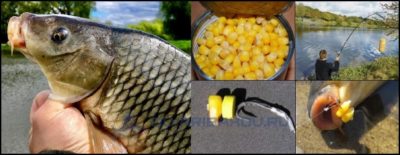
There are practically no technical features as such. Carp are caught with corn in the same way as with other baits. It is advisable to start fixing the place a few days in advance. If this is not possible, you will have to limit yourself to complementary feeding: starting feeding at the beginning and periodic supplementary feeding during the fishing process.
Attention. When feeding, you need to proceed from the fact that corn is a very high-calorie food for carp and carp. The fish can quickly get enough of it. Therefore, if bulk corn is used as bait, it is usually necessary to throw it into the water in moderation. The colder the water, the slower the current and the smaller the carp you expect to see in your catches, the more relevant this rule is. When hunting for medium-sized and especially trophy specimens, you can feed in almost any quantity - carps weighing from 5 kg can eat as much bait as you offer them, and will still remain hungry.
When the hook point is open, as it should be when fishing with corn, the fish is caught well. If a blind installation is used, self-cutting often occurs; if a sliding installation is used, you have to cut it yourself, and it is important not to miss the right moment.
